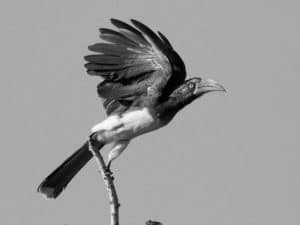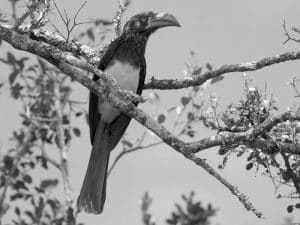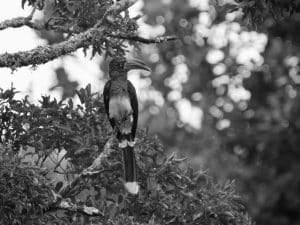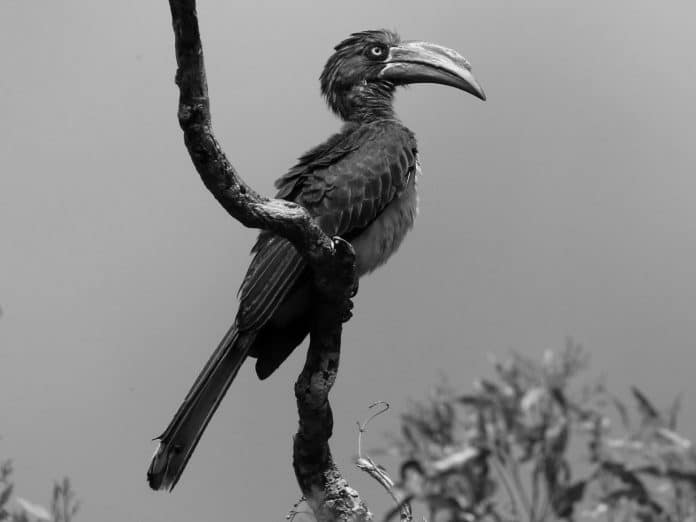Introduction to the Crowned Hornbill
Welcome to the enchanting world of the crowned hornbill, a magnificent bird that graces the forests of Tanzania with its majestic presence. The crowned hornbill in Tanzania, known for its striking appearance and unique behaviors, is a true gem of the avian world. With its regal crown and distinctive call, this bird captures the imagination of birdwatchers and nature enthusiasts from around the globe. In this article, we will delve into the habitat, behavior, conservation, and cultural significance of the crowned hornbill, offering a comprehensive look at this iconic species in the Tanzanian forests.

The crowned hornbill, scientifically classified as Tockus alboterminatus, is a species of hornbill found in the woodlands and savannas of eastern and southern Africa, including the lush forests of Tanzania. One of the most striking features of the crowned hornbill is its prominent casque, or horn, on top of its bill, which gives it a distinctive appearance that sets it apart from other avian species. Its striking black and white plumage, coupled with a vibrant red gular pouch, make it a sight to behold in its natural habitat. As we explore the habitat and distribution of the crowned hornbill in Tanzania, we will uncover the unique ecosystems that support the survival of this remarkable bird.
Habitat and Distribution of the Crowned Hornbill in Tanzania
The crowned hornbill is primarily found in the miombo woodlands, riverine forests, and coastal forests of Tanzania, where it thrives in the diverse array of plant life and abundant insect populations. These forests, characterized by their rich biodiversity and towering canopies, provide the perfect environment for the crowned hornbill to forage, nest, and carry out its daily activities. The distribution of the crowned hornbill extends across various regions of Tanzania, from the eastern coastal areas to the inland forests, allowing it to adapt to a range of habitats within the country. Understanding the habitat and distribution of the crowned hornbill is essential for conservation efforts and for identifying key areas where this species is most vulnerable to environmental threats.
The crowned hornbill’s reliance on intact forest ecosystems makes it particularly susceptible to habitat loss and degradation, due to factors such as deforestation, agricultural expansion, and human encroachment. As we examine the challenges faced by the crowned hornbill in Tanzania, it becomes evident that preserving its natural habitat is crucial for the long-term survival of this iconic bird. By gaining insights into the specific habitats and regions where the crowned hornbill is most prevalent, conservationists and policymakers can develop targeted strategies to safeguard these areas and ensure the continued presence of the crowned hornbill in Tanzania’s forests.
Behavior and Mating Habits of the Crowned Hornbill
The behavior and mating habits of the crowned hornbill offer a fascinating glimpse into the life of this remarkable bird. Known for its distinct vocalizations and social interactions, the crowned hornbill exhibits a range of behaviors that reflect its role within the forest ecosystem. From its foraging techniques to its nesting habits, the crowned hornbill’s behavior is shaped by its environment and the intricate dynamics of its avian community. As we delve into the behavior and mating habits of the crowned hornbill, we uncover the intricate social structures and reproductive strategies that define this species in the Tanzanian forests.
The crowned hornbill is a highly vocal bird, using its distinctive calls to communicate with its mate, establish territory, and convey warnings to other members of its species. These vocalizations, often characterized by a series of melodious notes and loud calls, are integral to the crowned hornbill’s social interactions and play a key role in its courtship rituals. During the breeding season, male crowned hornbills engage in elaborate courtship displays, showcasing their vibrant plumage and engaging in synchronized flights to attract potential mates. The intricate mating rituals and bond-building behaviors of the crowned hornbill underscore the significance of these avian relationships within the context of the Tanzanian forests.
Conservation Efforts for the Crowned Hornbill in Tanzanian Forests
The conservation of the crowned hornbill in Tanzanian forests is a critical endeavor that requires concerted efforts to address the various threats facing this iconic species. As human activities continue to impact the natural landscapes of Tanzania, the crowned hornbill faces significant challenges related to habitat loss, hunting, and the illegal wildlife trade. Conservation efforts aimed at protecting the crowned hornbill involve a multi-faceted approach that encompasses habitat preservation, community engagement, and anti-poaching initiatives. By understanding the specific conservation efforts for the crowned hornbill, we can gain valuable insights into the strategies employed to safeguard its future in the Tanzanian forests.
One of the key conservation initiatives for the crowned hornbill involves the establishment and management of protected areas and wildlife reserves that serve as critical habitats for this species. These protected areas, which range from national parks to community-managed forests, play a vital role in providing sanctuary for the crowned hornbill and other wildlife. Additionally, conservation organizations and local communities collaborate to implement sustainable forestry practices, promote ecotourism, and raise awareness about the importance of preserving the crowned hornbill’s habitat. By fostering a harmonious relationship between conservation efforts and the livelihoods of local communities, these initiatives contribute to the long-term well-being of the crowned hornbill in Tanzanian forests.
Best Places to Witness the Crowned Hornbill in Tanzania

For birdwatchers and nature enthusiasts seeking to witness the crowned hornbill in its natural habitat, Tanzania offers a diverse range of locations that provide exceptional opportunities for observing this iconic bird. From the coastal forests of the Eastern Arc Mountains to the sprawling woodlands of the Southern Highlands, Tanzania’s varied landscapes are home to thriving populations of crowned hornbills. By exploring the best places to witness the crowned hornbill in Tanzania, visitors can embark on unforgettable journeys into the heart of the country’s natural wonders, where the sights and sounds of these majestic birds await.
One of the prime locations for encountering the crowned hornbill is the Udzungwa Mountains National Park, a renowned conservation area that harbors a rich tapestry of biodiversity, including an array of avian species such as the crowned hornbill. The lush montane forests of Udzungwa provide an idyllic setting for birdwatching, with guided treks and nature walks offering the chance to spot crowned hornbills amidst the verdant foliage. Additionally, the Selous Game Reserve, the largest protected area in Africa, boasts extensive woodlands and riverine habitats that are home to diverse birdlife, making it another noteworthy destination for witnessing the crowned hornbill in its natural environment.
Tips for Birdwatching and Photographing the Crowned Hornbill
Birdwatching and photographing the crowned hornbill in Tanzania require a combination of patience, preparation, and an understanding of the bird’s behavior and habitat preferences. Whether you are an experienced birder or a novice enthusiast, employing the right techniques and strategies can enhance your chances of capturing memorable sightings and images of the crowned hornbill. By incorporating tips for birdwatching and photographing the crowned hornbill, you can elevate your wildlife encounters and create lasting memories of this iconic bird in the Tanzanian forests.
When venturing into the forests of Tanzania to seek out the crowned hornbill, it is essential to equip yourself with the appropriate gear, including binoculars, a reliable camera with a telephoto lens, and comfortable attire for outdoor exploration. Familiarizing yourself with the vocalizations and calls of the crowned hornbill can aid in locating and identifying these birds amidst the forest canopy, while also adding an auditory dimension to your birdwatching experience. Additionally, engaging local guides and naturalists who possess knowledge of the crowned hornbill’s habits and favored foraging areas can greatly enhance your chances of successful sightings and photography opportunities.
The Importance of Ecotourism in Protecting the Crowned Hornbill
Ecotourism plays a pivotal role in protecting the crowned hornbill and its habitat in Tanzanian forests, offering a sustainable approach to conservation that benefits both the wildlife and local communities. By embracing ecotourism as a means of supporting conservation efforts, visitors contribute to the preservation of natural landscapes while also engaging in responsible travel practices that minimize negative impacts on the environment. The importance of ecotourism in protecting the crowned hornbill underscores the significance of ethical and sustainable tourism as a catalyst for safeguarding the biodiversity and cultural heritage of Tanzania’s forests.
Through ecotourism initiatives, travelers have the opportunity to partake in guided birdwatching excursions, nature walks, and wildlife safaris that showcase the beauty of the crowned hornbill and its fellow inhabitants of the Tanzanian forests. These experiences foster a deeper appreciation for the natural wonders of Tanzania, while also directly supporting local initiatives focused on conservation, community empowerment, and environmental education. Furthermore, ecotourism revenue contributes to the funding of conservation projects, anti-poaching efforts, and the establishment of protected areas, thereby creating a positive cycle of investment in the well-being of the crowned hornbill and its ecosystem.
Cultural Significance of the Crowned Hornbill in Tanzanian Folklore
The crowned hornbill holds a profound cultural significance in Tanzanian folklore, where it is revered as a symbol of wisdom, strength, and spiritual significance. Across various indigenous communities in Tanzania, the crowned hornbill features prominently in traditional stories, rituals, and artistic expressions, reflecting the deep-rooted connection between the bird and the cultural heritage of the region. By exploring the cultural significance of the crowned hornbill in Tanzanian folklore, we gain insights into the enduring relationship between humans and nature, and the intrinsic value of this avian icon in the cultural tapestry of Tanzania.
In the folklore of the Maasai people, the crowned hornbill is associated with qualities of leadership and foresight, often depicted as a messenger between the earthly realm and the spirit world. Its distinctive appearance and regal bearing have inspired stories and proverbs that celebrate the virtues of courage, perseverance, and communal harmony, serving as guiding principles for generations. Similarly, among the Sukuma and Chaga communities, the crowned hornbill is revered for its role in traditional ceremonies and as a totemic symbol representing ancestral wisdom and the interconnectedness of all living beings. The cultural significance of the crowned hornbill underscores its enduring presence in the hearts and traditions of Tanzanian society.
Conservation Organizations Working to Protect the Crowned Hornbill

The conservation of the crowned hornbill in Tanzanian forests is championed by dedicated organizations and initiatives that are committed to safeguarding the species and its habitat. These conservation organizations work tirelessly to address the various threats facing the crowned hornbill, from habitat destruction to poaching, and collaborate with local communities and governmental agencies to implement effective conservation strategies. By highlighting the efforts of conservation organizations working to protect the crowned hornbill, we recognize the collective resolve and passion driving the conservation of this iconic bird in Tanzania.
One such organization, the Wildlife Conservation Society (WCS), actively engages in research, monitoring, and advocacy to support the conservation of the crowned hornbill and other wildlife species in Tanzania. Through field studies and community-based projects, the WCS contributes to the protection of critical habitats and the promotion of sustainable resource management, fostering a harmonious coexistence between people and nature. Additionally, the Tanzania Forest Conservation Group (TFCG) plays a pivotal role in advancing forest conservation and biodiversity preservation, advocating for the sustainable management of forests and the enforcement of anti-poaching measures that benefit the crowned hornbill and other forest-dwelling species.
Conclusion: Preserving the Majesty of the Crowned Hornbill
In conclusion, the crowned hornbill stands as a symbol of natural splendor and cultural significance in the forests of Tanzania, captivating the hearts and minds of those who seek to witness its majestic presence. By understanding the habitat, behavior, and conservation of the crowned hornbill, we gain a profound appreciation for the interconnectedness of wildlife, ecosystems, and human communities. Preserving the majesty of the crowned hornbill requires collective action, sustainable practices, and a deep reverence for the intrinsic value of this avian icon. As we advocate for the conservation of the crowned hornbill in Tanzanian forests, we uphold a legacy of stewardship and admiration for the natural world, ensuring that future generations can continue to marvel at the splendor of the crowned hornbill in its verdant habitat. Join us in celebrating the beauty of the crowned hornbill and standing as guardians of its timeless legacy in the forests of Tanzania.


































